Martin P.M. Handbook of Deposition Technologies for Films and Coatings, Third Edition: Science, Applications and Technology
Подождите немного. Документ загружается.


Characterization of Thin Films and Coatings 761
[26, 27]. Because of the advancements in instrument engineering, technology, and
computational aspects, XRD methods are being applied for a wide range of materials, enabling
answers to many different types of diffraction challenges. Many of these methods apply to
characterization of thin films. Applications include phase analysis, determination of crystalline
structure and epitaxial orientation, measurement of thickness and interfacial roughness,
determination of texture and residual stress in films, studies of nanomaterial development and
measurements of their reactivity, and polymorph screening. Furthermore, XRD measurements
can be made in non-ambient conditions allowing study of dynamic processes such as reactions
involving the solid state, phase transitions, crystallite growth, and thermal expansion.
Although the XRD can be applied in many frontiers of research and developments, the scope
of this article is restricted to thin films.
XRD is especially valuable as a tool to understand the growth and characterization of epitaxial
layers and other thin film materials. Using one of the state-of-the-art laboratory-based
high-resolution X-ray diffraction (HRXRD) instruments available today, lattice parameters
(both in-plane and out-of-plane) of an epitaxial layer can be determined with great precision.
Another interesting use of HRXRD for thin films is the determination of the thermal expansion
coefficient by plotting lattice parameters obtained (usually from non-ambient measurements)
as a function of temperature. The orientation relationship between the epitaxial layer and the
substrate can be analyzed by X-ray pole-figure measurements. Whether any polycrystalline
materials are present in the epitaxial layer can be determined by glancing-incidence X-ray
diffraction (GIXRD) measurements. The thickness of the thin film and the interface roughness
between the thin film and the substrate can be determined by XRR measurements and
modeling, not only for simple thin films but also for multilayered structures. All these
parameters can be important for advanced materials used in high-tech devices in order to
understand the device performance and failure. In the following sections, each technique is
described and specific detailed examples are provided.
16.3.2.1 High-Resolution X-Ray Diffraction
HRXRD is useful for careful measurements of small changes in the lattice parameter which
may result from strain, doping elements into the host lattice, or other effects. HRXRD can be
obtained using a laboratory-based triple-axis (four-circle) diffractometer. It requires a sealed
X-ray tube or rotating anode, a mirror with a four-bounce duMond–Hart–Bartels (dHB) design
monochromator to isolate Kα
1
in the incident beam path, and a two- or three-bounce
monochromator in front of the detector. Usually a Ge(220) crystal monochromator is used. A
Ge(440) crystal monochromator can be used to further improve the resolution at the expense
of intensity.
As one example of measured changes in lattice parameter, the HRXRD spectra collected from
6H–SiC films at room temperature and after three different levels of H
+
irradiation
(610 H
+
/nm
2
at 340 K, 880 and 1870 H
+
/nm
2
at 210 K) for out-of-plane (00012) and in-plane
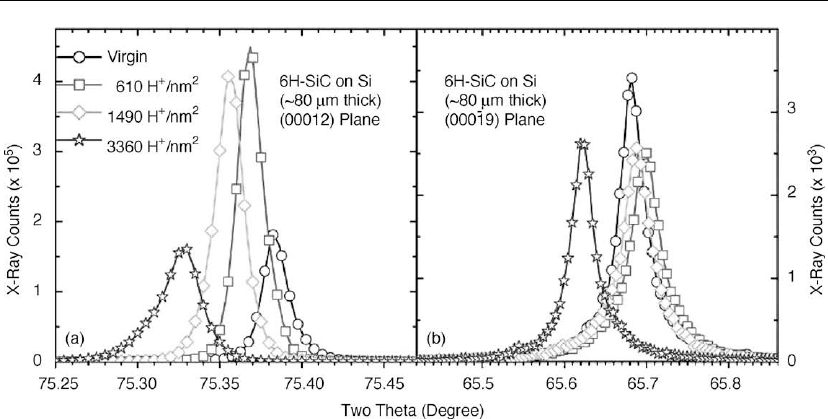
762 Chapter 16
Figure 16.8: HRXRD 2θ–ω scans for (a) (0, 0, 0, 12) and (b) (10
¯
19) planes in the 6H–SiC single
crystal film before and after irradiation using 610 H
+
/nm
2
at 340 K, followed by additional
fluences of 880 and 1870 H
+
/nm
2
at 210 K [28]. The different two theta angles for these peaks
show differences in lattice parameter due to the hydrogen irradiation.
(10
¯
19) reflections are reproduced in Figure 16.8[28]. A Philips X’Pert materials research
diffractometer with a fixed Cu anode operating at 45 kV and 40 mA was used for the
measurements. A hybrid monochromator, consisting of four-bounce Ge(220) crystals and a Cu
X-ray mirror, was employed in the incident beam path to provide monochromatic X-rays from
Cu Kα
1
(λ = 0.154056 nm and λ/λ ∼23 ppm) with a beam divergence of 12 arc sec. An
additional monochromator with a three-bounce Ge(220) channel-cut analyzer was placed in
front of a proportional counter in the diffracted beam path with the same beam divergence. The
diffractometer had the angular precision and reproducibility of 0.0001
◦
and 0.0003
◦
,
respectively, for both polar (θ) and tilt angles (ϕ).
A manual procedure involving multiple scans of ω,2θ–ω, and azimuthal angle ϕ was followed
to achieve a similar condition for each of the HRXRD measurements. In order to determine the
c-axis lattice parameter c, systematic scans of 2θ–ω were performed over 2θ = 30–80
◦
with a
step of 0.005
◦
per 4 s. Seven diffraction peaks from 6H–SiC (0006) to (0, 0, 0, 12) planes are
detected without reflection contributions from the Si substrate (not shown). For better
accuracy, only the (0, 0, 0, 12) peak at the highest angle was selected for lattice parameter
calculation. Similarly, for determination of the a-axis lattice parameter a,2θ–ω scans around
the (10
¯
19) plane were conducted from 2θ = 63.7–67.7
◦
at a step of 0.005
◦
per 5 s. By taking
one angular step (0.005
◦
) as the peak position uncertainty, the experimental error for
measuring parameters c and a in this study can be estimated to be |δc|= 0.00017 nm
(|δc/c|= 0.01%) and |δa|= 0.00006 nm (|δa/a|= 0.02%), respectively.
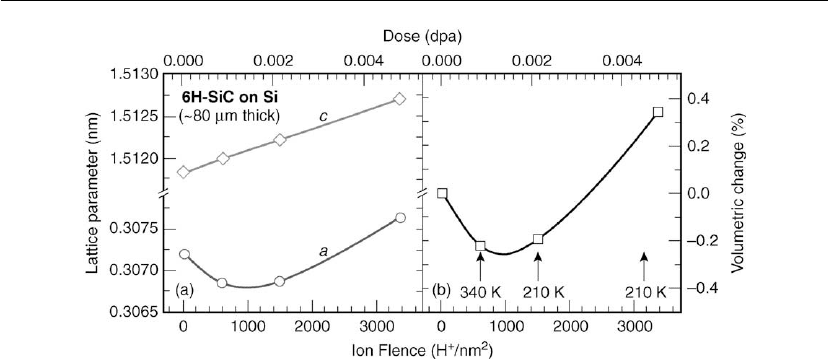
Characterization of Thin Films and Coatings 763
Figure 16.9: (a) Lattice parameters and (b) volumetric changes of the 6H–SiC single crystal film
before and after irradiation to 610 H
+
/nm
2
at 340 K, followed by additional fluences of 880 and
1870 H
+
/nm
2
at 210 K. This information was extracted from the data collected in Figure 16.8.
The dose in displacements/atom is estimated at a depth of 40 m [28].
For out-of-plane and in-plane reflections, the diffraction peak positions shift as ion fluence
increases. Although the magnitude of the shifts is small, it is well above the experimental
error. The lattice parameters obtained from Figure 16.8 and corresponding volumetric changes
of the 6H–SiC single crystal film prior to and following irradiation to 610 H
+
/nm
2
at 340 K,
followed by additional fluences of 880 and 1870 H
+
/nm
2
at 210 K, are shown in Figure 16.9.
The c-axis lattice parameter increases monotonically with the increasing dose, while a-axis
lattice parameter decreases at extremely low doses. An initial volumetric contraction of the
unit cell is observed. The decrease in the a parameter may originate from the
irradiation-induced vacancies and the possible formation of antisite defects that cause the
lattice structure on the basal plane to shrink [29].
16.3.2.2 Texture and Pole Figures
The texture of a material or film is the distribution of crystallographic orientations of grains in
a sample. There are several different possible situations for a film grown on a single crystal
substrate: (1) If the thin film is ‘epitaxial’, the single extended crystal has near-perfect registry
with same orientation as the under layer which is also nearly perfect; (2) If the thin film is
‘textured epitaxial’, the layer orientation is close to registry with the underlayer, both normal
and parallel to the surface plane, and the layer is composed of mosaic blocks; (3) When the
film is ‘textured polycrystalline’, the crystallites are preferentially oriented normal to the
surface and randomly oriented in plane and there will be a distribution of crystallite sizes.
Texture is seen in almost all engineered materials, and it can have a great influence on material
properties. Texture is often represented using a ‘pole figure’, in which a specified
crystallographic axis (or pole) from each of a representative number of crystallites is plotted in
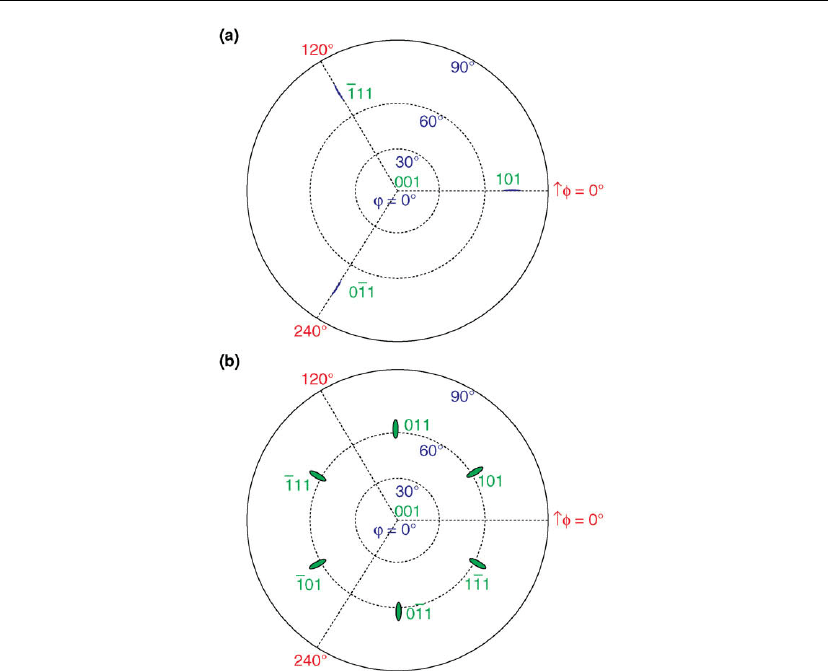
764 Chapter 16
Figure 16.10: Pole figures from a ZnO film grown on an alumina substrate. The figures are for
(a) the Al
2
O
3
(202) X-ray reflections, and (b) ZnO (101) X-ray reflections. The ZnO film was
grown in 10 mtorr H
2
on α-Al
2
O
3
(001) at 500
C. The pole elongation along the radial direction
is an instrumental effect from the line-focused X-ray optics [30]. The single crystal nature and
orientation of the substrate are demonstrated in (a) and the epitaxial orientation and domain
structure of the ZnO films grown at 500
C in (b).
a stereographic projection, along with directions relevant to the material’s processing history.
The pole-figure measurements provide information regarding preferred orientation, the
epitaxial relationship between the thin film and the substrate, and single or multiple in-plane
domains present in a thin film.
The pole figures for a ZnO film grown by pulsed laser deposition (PLD) on α-Al
2
O
3
(001)
substrate in 10 mtorr of H
2
at 500
◦
C are shown in Figure 16.10(a, b) for Al
2
O
3
(202) reflections
from the Al
2
O
3
substrate and ZnO(101) reflections from the thin film, respectively [30]. The
elongation of the poles along the radial direction is an instrumental effect from the line-focused

Characterization of Thin Films and Coatings 765
X-ray optics. The goniometer was set to ZnO(101) reflection for ZnO(001) oriented film on
Al
2
O
3
(001) substrate and all the reflections that are parallel to the [101] direction were
observed. Similarly, the goniometer was set to Al
2
O
3
(202) reflection for Al
2
O
3
substrate and
all the reflections parallel to the [202] direction were detected. By comparing the experimental
data with the theoretical stereographic projections, the epitaxial relationship between the thin
film and the substrate, and the number of in-plane domains in the thin film were determined. In
the present example, ZnO films grown on α-Al
2
O
3
(001) at 500
◦
C show pole figures which are
characteristic of epitaxial ZnO(001) with a single domain rotated 30
◦
in-plane about [001].
16.3.2.3 Glancing-Incidence X-Ray Diffraction
The GIXRD technique has been developed for the analysis of polycrystalline thin films on
single crystal substrates. In GIXRD, the X-ray beam is incident at a small angle (∼5
◦
), and the
detector is scanned over a 2θ range of interest and is an asymmetric scan. The X-ray incidence
angle and the slit size can be determined for a given instrument configuration based on the
sample dimension for complete X-ray coverage of the sample surface to improve the
sensitivity. In GIXRD, diffraction will be detected only from polycrystalline materials, unlike
epitaxial thin films and single crystal substrates, as the Bragg condition will not be satisfied
under this configuration. This technique is used to verify the presence or absence of any
polycrystalline material in epitaxial thin films on single crystal substrates. As a representative
example, GIXRD pattern from ∼50 nm thick ZnO film grown on Al
2
O
3
(001) following
annealing at 1000
◦
C for 3 hours is shown in Figure 16.11 [31]. The ZnO thin film is (001)
oriented preferentially as confirmed by HRXRD, and the substrate is Al
2
O
3
(001) oriented
single crystal. It can be seen from Figure 16.11 that the cubic ZnAl
2
O
4
phase has been
identified. The lattice parameter from GIXRD pattern is found to be 0.8106 nm. This value is
comparable to the literature value of 0.80848 nm (PDF# 005-0669) [32]. High-temperature
annealing results in diffusion of Al from the Al
2
O
3
substrate to ZnO thin film. Though the
thickness of the ZnO film is ∼50 nm, it becomes possible to identify the polycrystalline
ZnAl
2
O
4
phase because of the GIXRD principle.
16.3.2.4 X-Ray Reflectivity
In many advanced technologies, thin layered films become increasingly important.
Single-layer or multilayer structures can be found in all kinds of research and development
environments. Thus there is an increasing need to precisely characterize these thin layer
structures. Measurements of layer thickness, interface roughness, and layer density are
important to analyze and control development and production processes. XRR is a powerful
non-destructive technique to characterize thin layers. Far below the critical angle of total
external reflection, X-rays penetrate only a few nanometers (2–5 nm) onto thin film. Above the
critical angle, the probing depth increases rapidly. XRR measurements allow the density,
thickness, and roughness of external and internal interfaces of thin films to be determined. A
minimum layer thickness of 1 nm and density changes of ∼1–2% can be measured under
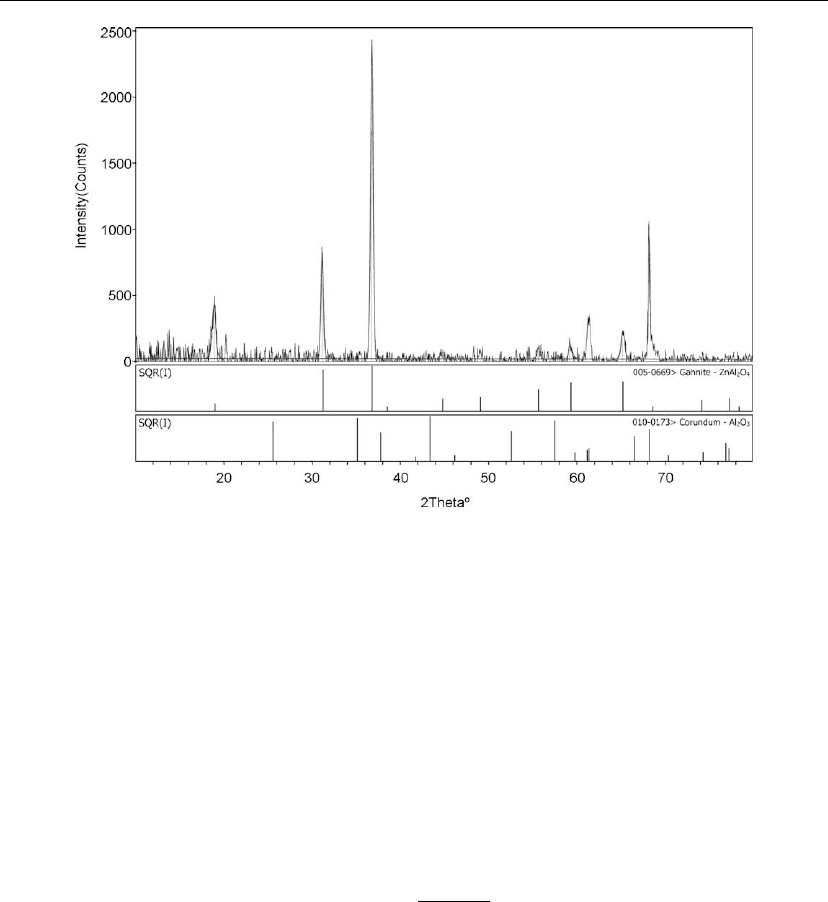
766 Chapter 16
Figure 16.11: Glancing-incidence X-ray diffraction (GIXRD) pattern from ZnO film grown on
α-Al
2
O
3
(001) following annealing at 1000
C for 3 hours [31]. These data confirm the highly
oriented nature of the films and the presence of a ZnAl
2
O
4
phase. The peaks around 61
and 69
represent the diffraction from the substrate.
optimum sample conditions. This method is sufficiently sensitive to provide precise
information on the presence of interface layers in layered structures.
As a representative example, XRR specular curves for Fe/Al and Al/Fe films grown on Si are
shown in Figure 16.12 together with theoretical simulation (solid lines) [33, 34]. The
engineered thin film structures are not perfectly smooth and possess surface and/or interface
roughness. While the presence of surface roughness decreases the specular intensity of the
whole curve progressively, interface roughness gives rise to progressive damping of the
Kiessig fringes. The interface roughness, σ, consists of topological roughness, σ
T
, and
chemical roughness, σ
C
, via the relation σ =
√
σ
C
+ σ
T
. Therefore, XRR diffuse scans are
essential to separate the topological and chemical roughness for an interface. The film
thickness measured from RBS and XRR, and the interface roughness from both specular and
diffuse scans, are shown in Table 16.3 for the bilayer films of Fe/Al and Al/Fe.
Topological roughness affects the reflectivity by scattering X-rays into non-specular
directions, whereas chemical roughness leads to more gradual changes in electron density at
the interfaces, and thus reduces the reflectivity of X-rays at the interface. The sixth column in
Table 16.3 shows the chemical roughness, σ
C
, of each layer determined by fitting XRR diffuse
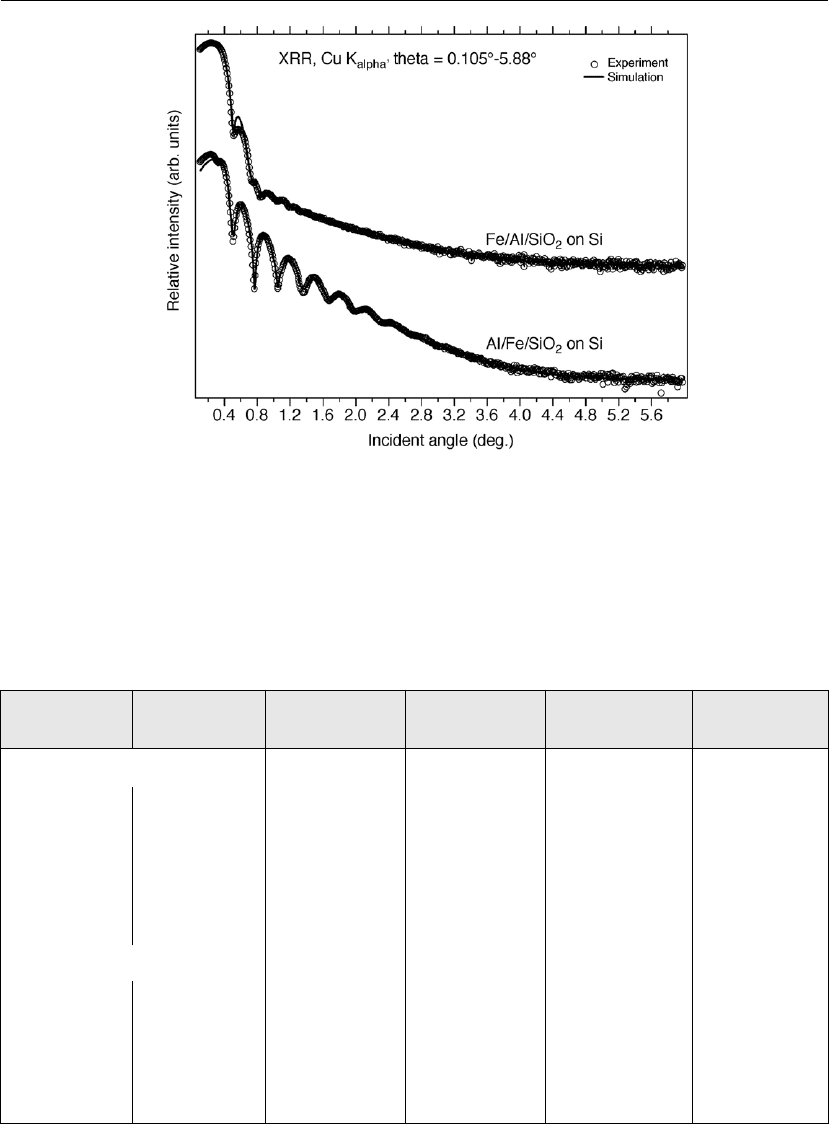
Characterization of Thin Films and Coatings 767
Figure 16.12: XRR specular scans (open circles) and BEDE simulations (solid lines) for bilayer
films of Fe/Al (upper curve) and Al/Fe (lower curve) [33].
Table 16.3: Layer structure, thickness, and total roughness (chemical and topological) of individ-
ual layers determined by fitting RBS and XRR spectra for (a) Fe/Al/SiO
2
on Si and (b) Al/Fe/
SiO
2
on Si
Layer No. Layer RBS, t XRR, t XRR, XRR,
c
(
˚
A) (
˚
A) (
˚
A) (
˚
A)
(a) Fe/Al/SiO
2
on Si
1Fe
2
O
3
46 48.124.921.9
2 Fe 105 124.021.018.5
3 AlFe 25 41.119.417.8
4 Al 146 99.118.717.6
5Al
4
Si – 5.33.12.9
6 SiO
2
2454 2487.32.42.1
(b) Al/Fe/SiO
2
on Si
1Al
2
O
3
11.411.77.05.4
2 Al 140 140.92.82.6
3 AlFe 16 20.67.36.4
4 Fe 129 136.510.89.9
5 SiO
2
2362 2366.920.920.5

768 Chapter 16
scans. Total thicknesses of the individual layers, as listed in the fourth column of Table 16.3,
are determined by adding the contributions of the individual layer thickness and half of the
chemical roughness on each side of the respected layer. The intermixing lengths for Fe–Al
bilayers are 20.6
˚
A and 41.1
˚
A for Al/Fe and Fe/Al bilayer films, respectively. There is a
considerable difference between Fe–Al intermixing lengths depending on whether Al is
deposited on Fe or Fe is deposited on Al.
16.3.2.5 Strengths and Limitations of XRD and XRR
Strengths:
Non-destructive bulk technique for thin films, solids and liquid media.
Phase analysis, crystalline structure, epitaxial orientation, texture and residual stress
analysis are possible.
Reactions and polymorph screening.
Crystallite growth and thermal expansion coefficient can be obtained.
Film thickness and interface roughness can be measured.
Limitations:
Provides bulk information and requires minimum of 1–5 wt% for phase identification.
Thickness cannot be measured for thin film with roughness over 50 nm.
XRR does not work if there is no difference in electron density between the layers or
layer and substrate.
16.3.3 Raman and Infrared Spectroscopies
S. V. N. T. Kuchibhatla
Raman and infrared (IR) spectroscopies are optical methods used to study vibrational,
rotational, and other low-frequency modes and vibrational energies of molecules. They enable
information to be gathered about molecular bonds and their vibration modes. These two
optical methods are powerful tools that can be used to provide information about the molecular
structure and composition of surfaces, thin films, and coatings. The most important aspect of

Characterization of Thin Films and Coatings 769
practical interest is the complementary nature of Raman and IR spectra. For example, while
Raman is used for understanding spatial profiles of curing process in the paint industry, IR
spectroscopy is used for understanding the kinetics of the curing process. Further, some weak
or undetectable features in one technique exhibit strong characteristic features in the other.
16.3.3.1 Raman Spectroscopy (RS)
The Raman effect is a specific form of inelastic scattering of light that serves as the basis of RS
and has its origin in the curiosity of Sir C.V. Raman about the ‘color of the sea’ [35]. RS, the
analysis technique that uses Raman effect, was initially confined to the fundamental studies of
the physicists owing to the feeble nature of the signal from various samples and the tedious
data collection involved. However, with the availability of lasers as light sources, advanced
optical components, and computers for data acquisition and analysis, RS has evolved into a
powerful and routine analysis technique for multiple disciplines [36]. The uniqueness of the
Raman effect lies in its very high sensitivity to the bonds and their variations. Because of its
ability to provide molecular information in many different environments, it is widely used in
research and industry. As one industrial example, the paint industry uses this technique to
monitor the transformations in industrial coating in situ as part of their day-to-day
operations.
This section is divided into two parts: the basic principle and several applications. The
development of new instrumentation has widened the use of RS from liquid samples to
crystalline/amorphous solids, thin films, coatings, especially in the corrosion (prevention)
industry, along with significant use in fundamental research. Various useful applications of the
instruments will be briefly discussed, along with some of the variations in sample geometry.
Basic principle
RS relies on inelastic scattering of monochromatic light, usually from a laser in the visible,
near-IR, or near-ultraviolet (UV) range. The light interacts with phonons or other excitations in
the system, resulting in the energy of some of the incident photons being shifted up or down. A
Raman spectrum is a plot of the intensity of light as a function of frequency above and below
the frequency of the incident light. Light is observed as frequencies including that of the
incident photon (Rayleigh scattering) as well as frequencies reflecting the energy changes
owing to the inelastic (Raman) scattering. The latter depend on the molecular/electronic
structure of the molecules and the quantum mechanical selection rules for Raman scattering.
The separation of Raman lines and the Rayleigh line in the spectrum is a direct indication of
the vibrational frequencies of molecules or atoms in the crystal lattice. While the scattering
from the Raman process is known as ‘Stokes scattering’, the reverse process which arises from
previously existing excited vibrational states in the sample is known as ‘anti-Stokes
scattering’. Accordingly, while the Raman lines appear at lower absolute frequencies than the
Rayleigh line, the anti-Stokes lines appear at higher absolute frequencies in a spectrum. As the
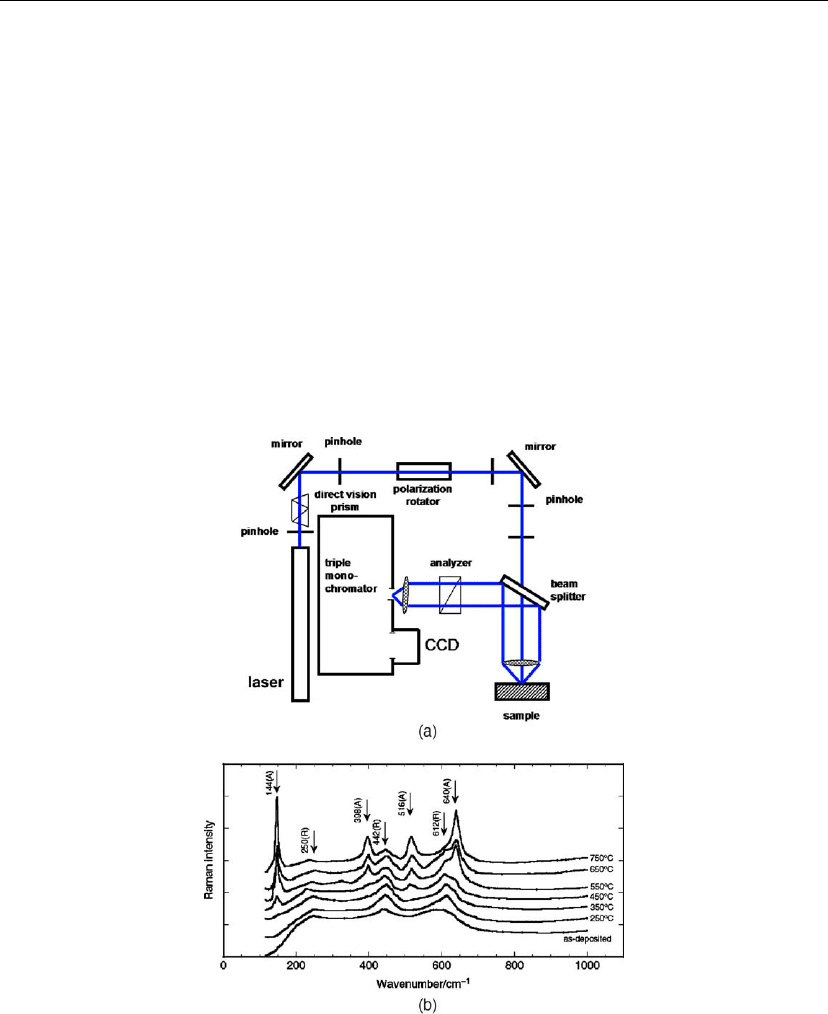
770 Chapter 16
anti-Stokes scattering is highly dependent on the population of the excited vibrational states, it
is only used in specialized cases of Raman analysis, as explained later in this section.
The intensity of Raman lines is 10
−3
to 10
−6
of the intensity of the Rayleigh lines, which
usually have their intensities in the range of 10
−3
to 10
−5
of the intensity of the incident
photon. This feeble nature of the intensity of Raman lines was a major issue for researchers
until the mercury discharge lamps were replaced with continuous gas lasers. This intense
monochromatic source, coupled with the double monochromator system, invented in 1965, to
discriminate the stray light resulted in the modern RS systems. The amount of material
analyzed is dependent on the optical density of the sample being measured. A schematic of RS
and the scattering lines are presented in Figure 16.13(a). When the light used for excitation is
focused on a small area, it is possible to conduct RS in a microscope mode with resolution at
the micrometer level.
Figure 16.13: (a) Line diagram of a Raman microscope showing a light source, optical
components to direct the light, the sample, a monochromator to separate parts of the optical
spectrum, and a detector (CCD). (b) Effect of temperature on the phase transformation in titania
(TiO
2
) films deposited by RF magnetron sputtering. (Figure 16.13(b) is taken from [40].)
